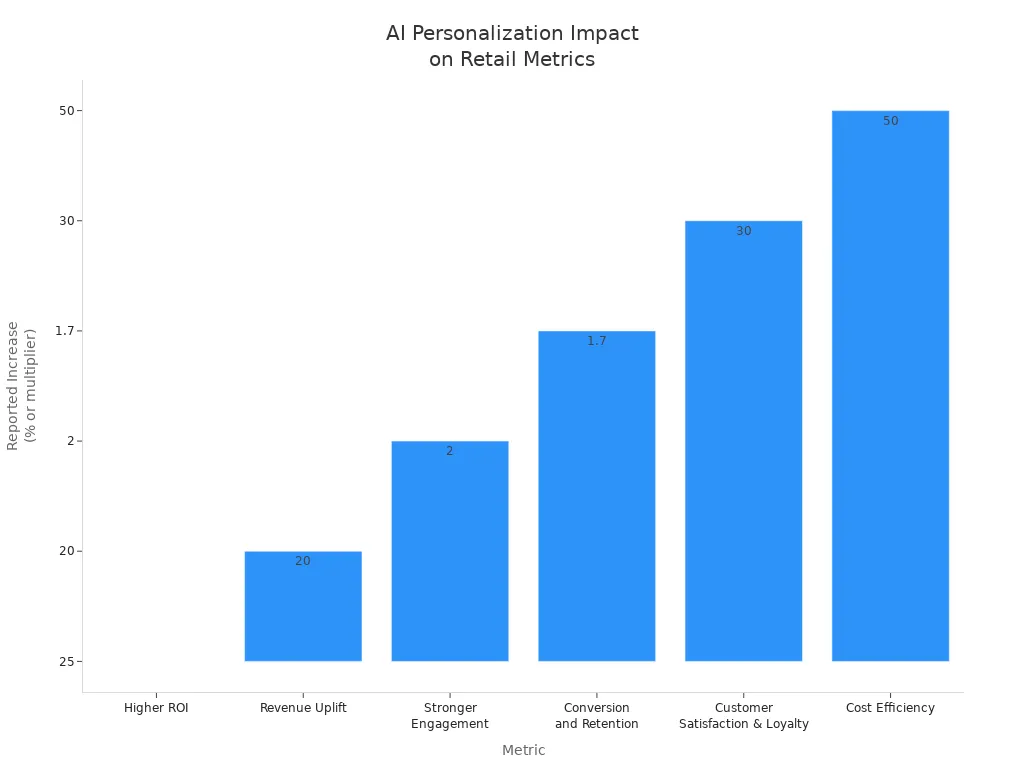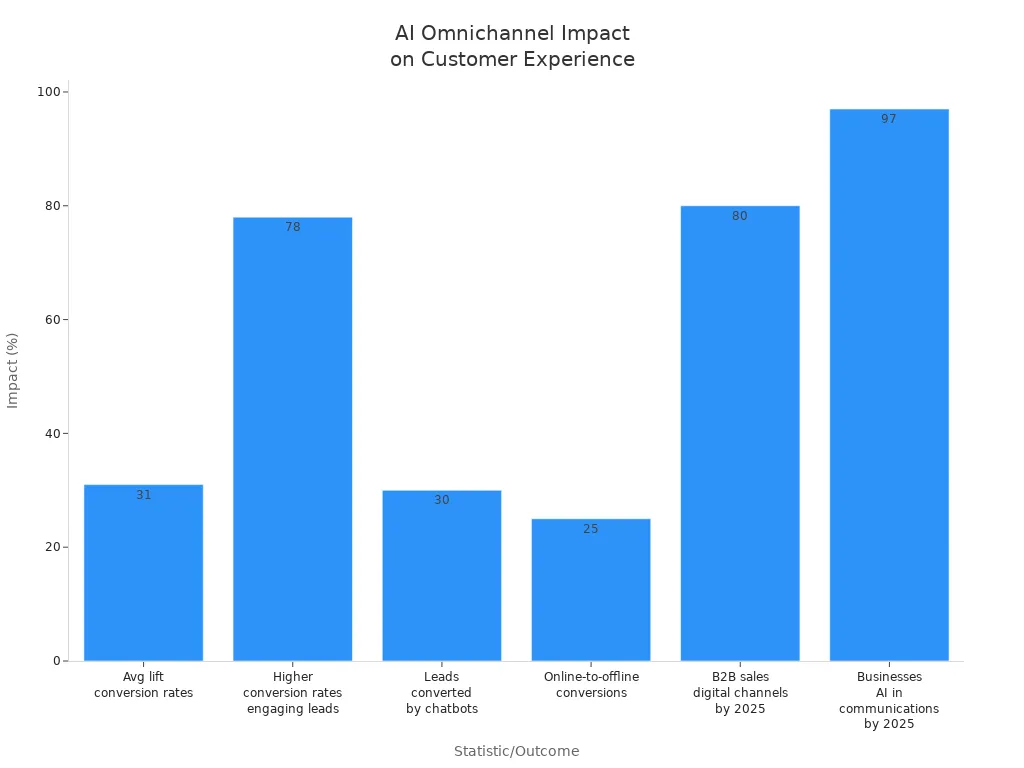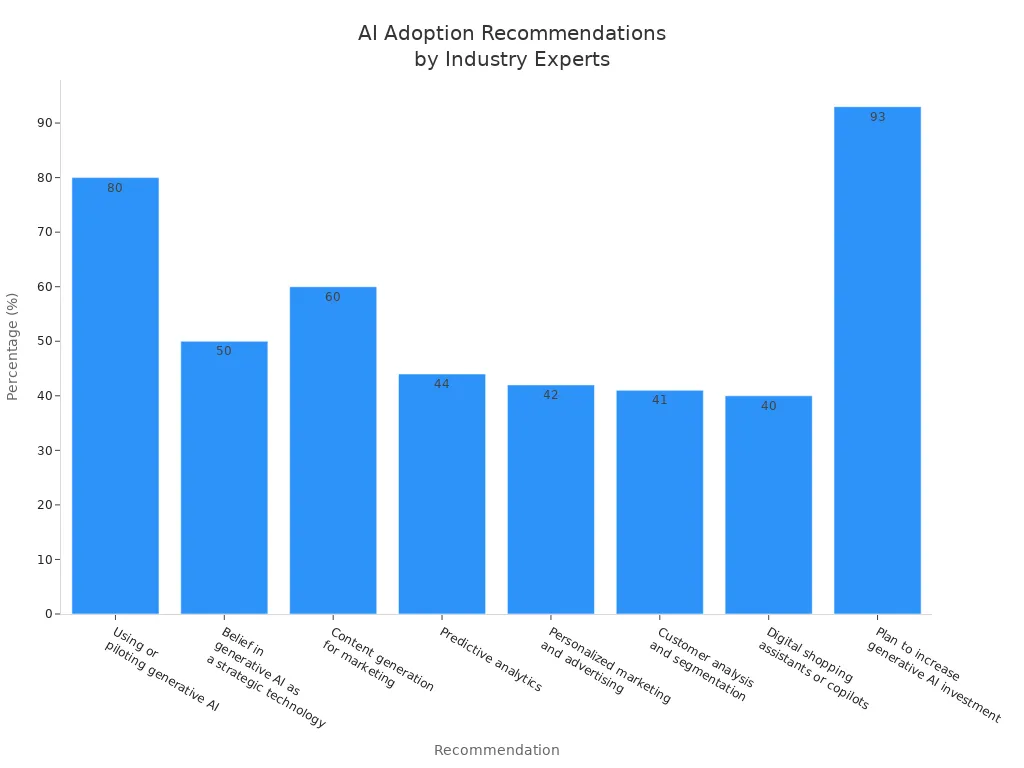Successful AI-powered retail store business models

You see AI changing how stores work every day. Some of the most successful AI-powered retail models include:
Personalized shopping assistants that boost order values, like on Amazon and Shopify.
Automated inventory management, which Warby Parker and Allbirds use to cut waste and keep shelves stocked.
Dynamic pricing, as seen at Zalando and Walmart, helping stores stay competitive and grow sales.
Smart checkout and AR tools, like Amazon Go and IKEA, making shopping faster and more fun.
Walmart’s AI even plans delivery routes and manages stock, leading to big jumps in sales and efficiency. These tools show how AI, especially with generative AI and edge computing, can transform how you shop and how stores run.
Key Takeaways
AI enhances the shopping experience by personalizing product recommendations, leading to increased customer satisfaction and higher sales.
Automated inventory management helps stores maintain stock levels, reducing waste and ensuring customers find what they want without empty shelves.
Smart checkout systems powered by AI speed up the purchasing process, saving customers time and improving overall store efficiency.
Dynamic pricing strategies allow retailers to adjust prices in real-time, attracting more customers and boosting profit margins.
Successful implementation of AI requires a clear strategy, quality data management, and ongoing staff training to adapt to new technologies.
AI in Retail

Definition
You might wonder what AI really means for retail stores. Different experts have their own take on it. Here’s a quick look at how some leading organizations define AI in retail:
Source | Definition |
|---|---|
SAP | AI in retail is the use of artificial intelligence to improve retail industry operations, enhance customer experience, and optimize merchandising, demand forecasting, and supply chain management. |
ARM | AI in retail involves the use of automation, data, and technologies such as machine learning (ML) algorithms to deliver highly personalized shopping experiences to consumers. |
The Retail Bulletin | AI has become a key driver of digital transformation in the retail industry, making it an essential part of every retail company’s strategy. |
APU | AI-driven analytics provide retailers with valuable insights into customer behavior by allowing for data-driven decision-making and the analysis of customer interactions. |
You see that AI is more than just robots or fancy gadgets. It’s about using smart technology to make your shopping easier, help stores run smoother, and give you better choices.
Importance
Why does AI matter so much in retail today? You see stores using AI for many reasons. Here’s a table that shows the main benefits:
Benefit | Description |
|---|---|
AI enables personalized interactions and improved customer engagement. | |
Optimized Inventory Management | AI helps in managing stock levels and supply chain efficiency. |
Improved Operational Efficiencies | AI streamlines processes, leading to cost reductions and better resource allocation. |
You also find AI helping with:
Inventory management
Marketing campaigns
Customer behavior analysis
Demand forecasting
Price optimization
AI lets you enjoy faster checkouts, smarter product suggestions, and better prices. Retailers use AI to predict what you want, keep shelves stocked, and run successful AI-powered retail stores. When stores use AI, they make smarter decisions and create a better shopping experience for you. You get more choices, and stores work more efficiently. That’s why AI is now a must-have for any retailer who wants to stay ahead.
Successful AI-powered retail models

Personalization
You probably notice how stores seem to know exactly what you want. That’s AI-driven personalization at work. When you shop online, brands like Amazon and Nike use smart engines to recommend products based on your browsing history, past purchases, and even your mood. You get suggestions that fit your style, making shopping easier and more fun.
PATTERN Beauty uses AI to match products to your hair type. This helps you find what you need faster and increases your chances of buying something new. Stores see big results from these systems. Marketers using AI personalization report a 25% increase in marketing ROI. Companies see an average 20% sales boost, and customer engagement rates double. You also get better deals and more relevant offers, which makes you want to come back.
Here’s a quick look at how some retailers benefit from personalization:
Retailer | Measurable Outcome |
|---|---|
Amazon | Customers who engage with recommendations spend 29% more per session and show 73% higher customer lifetime value. |
ASOS | Average order value increased by 25%. |
Wayfair | Conversion rate improved by 40% and return rates reduced by 18%. |
Nike | Tailored promotions and dynamic pricing boosted sales and customer satisfaction. |
Best Buy | Customer satisfaction scores improved and support costs reduced by 35%. |
You can see how personalization engines drive successful AI-powered retail strategies. They help stores connect with you, improve your shopping experience, and grow their profits.
Did you know? Netflix saves about $1 billion every year by using AI to personalize content and keep subscribers happy.

Inventory Automation
You might not think about inventory when you shop, but it’s a huge part of successful AI-powered retail. Stores like Walmart and Amazon use AI to track stock in real time, predict what will sell, and keep shelves full. This means you rarely see empty shelves or wait for restocks.
AI helps stores manage inventory by analyzing sales data, trends, and even weather patterns. You get the products you want, and stores avoid wasting money on items that don’t sell. Real-time tracking reduces stockouts and overstocking. Predictive analysis helps stores order just the right amount. Workflow optimization speeds up warehouse operations, so your orders arrive faster.
Here’s what AI inventory automation can do:
Reduced Labor Costs: Stores automate routine tasks, saving money on manual work.
Minimized Stockouts and Overstock: Smart systems keep inventory levels just right, so you find what you need.
Lower Holding Costs: Efficient management means less money spent on storage.
Stores report big wins with these systems. AI integration can cut excess inventory by up to 40%. Walmart’s FAST Unloader System increased worker productivity by 25%, reduced unloading time by 30%, and cut inventory errors by 90%. Amazon’s predictive inventory system reduced stockouts by 35%, making customers happier and saving money.
Smart Checkout
You want to get in and out of the store quickly. Smart checkout systems powered by AI make this possible. You scan your items, pay, and leave—no waiting in long lines. Stores like Aldi, Kroger, and Target use these systems to speed up the process and improve your experience.
AI-powered checkout reduces cashier idle time by almost 58%, saving over 2.5 man hours per store each day. These systems prevent queues and save you about 2.25 hours in wait time daily. During the pandemic, smart checkout helped stores run smoothly with fewer employees.
Here’s how smart checkout helps:
Shorter checkout times
Contactless payment options
Better security and loss prevention
Aldi saw a 20% drop in checkout-related labor costs after using Grabango’s technology. Kroger’s smart carts boosted customer satisfaction scores by 30% and increased average transaction value by 12%. Target’s express self-checkout lanes made shopping faster and safer.
Tip: Next time you use a self-checkout, remember that AI is working behind the scenes to make your experience smoother.
Dynamic Pricing
You may notice prices changing when you shop online. That’s dynamic pricing powered by AI. Stores adjust prices in real time based on demand, competition, and even your shopping habits. This keeps stores competitive and helps you find deals.
AI-driven dynamic pricing can improve profit margins by 5–10%. About 66% of shoppers expect personalized pricing and promotions, which makes you feel valued and keeps you coming back. Retailers see a 41% drop in cart abandonment and a 28% jump in click-to-purchase rates with tailored follow-ups. Promotion-driven revenue can rise by 35%.
Some real-world results:
Amazon uses dynamic pricing to grow revenue and market share.
A fashion retailer increased revenue by 18% in six months and cut costs by 15%.
Electronics and grocery stores saw revenue boosts of 10% and 8%, respectively.
Stores use dynamic pricing to create successful AI-powered retail strategies that attract more customers and increase profits.
Omnichannel Integration
You want a seamless shopping experience, whether you’re online or in a physical store. Omnichannel integration powered by AI makes this possible. Stores unify data from all channels to give you personalized offers, easy returns, and consistent service.
AI helps stores connect online and offline experiences. You can order online and pick up in-store, get personalized recommendations on your phone, and enjoy loyalty rewards wherever you shop. Starbucks lets you order and pay through their app, making your visit quick and easy.
Here’s how omnichannel integration improves your experience:
Statistic/Outcome | Impact/Result |
|---|---|
Average lift in conversion rates | 31% increase |
Higher conversion rates from engaging leads | 78% increase |
Increase in leads converted by smart chatbots | 30% more leads converted |
Increase in online-to-offline conversions | 25% increase |
B2B sales interactions occurring in digital channels | 80% by 2025 |
Businesses planning to incorporate AI in communications | 97% by 2025 |

About 71% of shoppers prefer personalized experiences across all channels. Stores invest in technologies that unify your shopping journey, making it easier to find what you want and get help when you need it. Data unification lets brands create tailored experiences that reflect your preferences.
You see successful AI-powered retail models everywhere. They help stores run better, improve your experience, and boost profits. Whether you’re shopping for shoes, groceries, or electronics, AI is making your journey smoother and more enjoyable.
Comparative Analysis
Effectiveness
You want to know if AI-powered retail models really work. Stores measure effectiveness using simple metrics. You might hear about inventory turnover rate, days of inventory on hand, and stockout rates. These numbers show how well stores keep products available and avoid waste. Retailers also test their AI systems with methods like train-test split, cross-validation, and real-world performance tracking. When stores use AI, they see faster restocking, fewer empty shelves, and better sales. For example, Best Buy’s AI system gives real-time inventory updates, so you can always find what you need. Walmart’s voice shopping lets you order with a simple command, making shopping easier and more fun.
Tip: Stores that track these metrics can spot problems early and fix them before you notice.
Scalability
You might wonder if AI works for all types of stores. The answer is yes! AI systems scale from small convenience shops to giant grocery outlets. You see digital tools that update quickly, so stores can add new products or change layouts without much hassle. Here’s a table that shows how scalability works:
Aspect | Description |
|---|---|
Scalability | Autonomous retail systems fit any store size, from tiny shops to big supermarkets. |
Adaptability | Digital systems update fast, so stores can change products or strategies easily. |
Many retailers use AI for layout optimization, considering store size and goals. You see features like buy-online-pickup-in-store (BOPIS) at Best Buy, virtual try-ons at Burberry, and personalized appointments at Tiffany & Co. These examples show how AI adapts to different needs and keeps stores competitive.
Challenges
You might think AI sounds perfect, but stores face real challenges. Some jump in without a clear plan, leading to confusion. Poor data quality can mess up recommendations and inventory. Old systems may not work well with new AI tools. Costs can be high, especially for small businesses. Stores also struggle with finding skilled workers and keeping customer data safe. Here’s a quick look at common challenges:
Challenge | Description |
|---|---|
Lack of Strategy | No clear plan leads to wasted effort. |
Poor Data Quality | Bad data hurts customer experience and efficiency. |
Integration Issues | Old tech slows down new AI tools. |
Cost Concerns | High upfront costs can scare off small stores. |
Talent Shortages | Not enough experts to run AI projects. |
Ethical Risks | Privacy and bias issues can hurt trust. |
Retailers solve these problems by building strong partnerships, using frameworks like the AI Implementation Compass, and focusing on change management. You see stores succeed when they plan carefully and help their teams adapt to new technology.
Implementation Strategies
Steps
You want to bring AI into your retail business, but you might not know where to start. Here’s a step-by-step guide to help you move forward:
Establish a Clear Strategy
Set your goals. Decide what you want AI to do for your store, like improving customer service or managing inventory.Invest in Data Management
Collect and organize your data. Clean, accurate data helps AI work better and gives you reliable results.Develop In-House Expertise
Train your team. Teach them how to use AI tools and understand the basics of data analytics.Select the Right Tools and Partners
Choose AI solutions that fit your needs. Work with trusted vendors or build your own systems.Focus on Data Security and Compliance
Protect your customers’ information. Follow privacy laws and keep data safe.Pilot and Test
Start small. Test AI in one area before rolling it out everywhere.Enhance Customer Experiences
Use AI to make shopping easier and more personal for your customers.Streamline Operations
Let AI handle routine tasks. This saves time and reduces mistakes.Make Data-Driven Decisions
Use analytics to guide your choices. Let real numbers show you what works.Keep Learning and Adapting
Stay curious. Update your systems as AI technology improves.
Tip: Start with one project, learn from it, and then expand. You don’t have to do everything at once!
Best Practices
You want your AI project to succeed. Here are some best practices to follow:
Set clear goals for each AI project.
Clean and centralize your data for better results.
Respect privacy and follow all data laws.
Train your staff so they feel confident using AI.
Test your AI tools often and make changes as needed.
Work together across departments to spark new ideas.
Use data and analytics to make smart decisions, not just guesses.
Keep improving your AI systems to stay ahead.
When you follow these steps and best practices, you set your store up for long-term success with AI.
You see AI changing retail every day. Smart stores use AI to predict what you want, personalize your shopping, and keep shelves stocked. You get faster checkouts and better prices. AI helps stores make quick decisions, streamline supply chains, and create exciting experiences for you. Experts say most retailers plan to invest more in generative AI, predictive analytics, and digital shopping assistants.

To keep up, you should focus on these tips:
Engage customers in new ways across every channel.
Use data to build fresh strategies.
Make your logistics flexible and ready for change.
Stay curious and keep adapting as AI grows. If you do, your store will stand out in a competitive world.
FAQ
What is the biggest benefit of using AI in retail stores?
You get a better shopping experience. Stores use AI to suggest products, keep shelves stocked, and speed up checkout. You find what you want faster and enjoy more personalized service.
How does AI help with inventory management?
AI tracks products in real time. You see fewer empty shelves and less wasted stock. Stores use smart systems to predict what you’ll buy next and order just enough.
Tip: Stores using AI for inventory often save money and reduce mistakes.
Can small stores use AI-powered tools?
Yes! You don’t need a huge budget. Many AI tools work for small shops. You can start with simple systems like smart checkout or product recommendations.
Store Size | AI Tool Example |
|---|---|
Small | |
Medium | Personalized offers |
Large | Automated inventory |
Is AI safe for customer data?
You can trust stores that follow privacy rules. Good retailers protect your information and use secure systems. Always check if a store explains its data policy.
Will AI replace retail workers?
AI helps workers, not replaces them. You see staff using AI to serve you better. Workers spend less time on boring tasks and more time helping customers.
See Also
The Future of Retail: Embracing AI-Driven Stores
Revolutionizing Online Retail Management with AI Tools
Essential Insights for Retailers on AI-Enhanced Corner Stores
Modern Retail Benefits from AI-Enabled Combo Vending Machines
